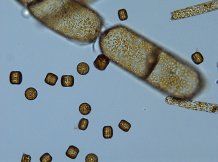New research sheds light on early mechanisms driving diatom bloom formation
Published on by Water Network Research, Official research team of The Water Network in Technology
 Marine diatoms under the light microscope. Credit Glen L Wheeler
Marine diatoms under the light microscope. Credit Glen L Wheeler
Scientists have discovered how diatoms (a globally important group of eukaryotic algae) sense the availability of phosphorus, a vital macronutrient that controls diatom growth and productivity in the oceans.
The research, published in the journal Current Biology, demonstrates a new role for calcium ion (Ca2+) signalling in eukaryotes, for phosphate sensing, which has not previously been described.
The study was carried out by joint University of Exeter and Marine Biological Association Research Fellow Dr Katherine Helliwell alongside MBA researchers Glen Wheeler and Colin Brownlee, and in collaboration with scientists at Plymouth Marine Laboratory (PML) and the University of Warwick.
Diatoms are responsible for 20% of global primary productivity, equivalent to that of terrestrial rainforests combined.
The study showed that phosphorus-starved diatoms used Ca2+-dependent signalling to perceive and coordinate rapid recovery responses to phosphorus resupply.
The researchers also demonstrated that one of the first adaptations to phosphorus resupply is substantial enhancement of the uptake of another essential nutrient, nitrogen.
This rapid crosstalk between phosphorus and nitrogen metabolism, coordinated by the novel phosphorus-Ca2+ signalling pathway, enhances diatom competition for two critical nutrients.
As major algal bloom formers, this work provides vital insight into how diatoms are so successful in rapidly responding to environmental cues such as nutrient supply, to dominate algal bloom formation.
Dr Katherine Helliwell, first author and a NERC Independent Research Fellow at the University of Exeter and MBA, said: “This work provides important new insight into how one of the most abundant marine phytoplankton groups is able to thrive in feast-famine nutrient regimes. Our study helps us to understand the cellular mechanisms employed by diatoms at the very early stages of bloom formation.”
As diatoms sustain coastal fish populations and marine food webs, gaining understanding of what drives the ecological success of diatoms is important to all of us, especially those who enjoy the pleasures of coastal ecosystems, from swimming in the sea, to eating fish and seafood.
The Helliwell Group studies environmental drivers regulating phytoplankton productivity, from understanding environmental signalling mechanisms to exploring the interactions between microbes, and their impact on marine microbial communities.
Taxonomy
- Algal Blooms